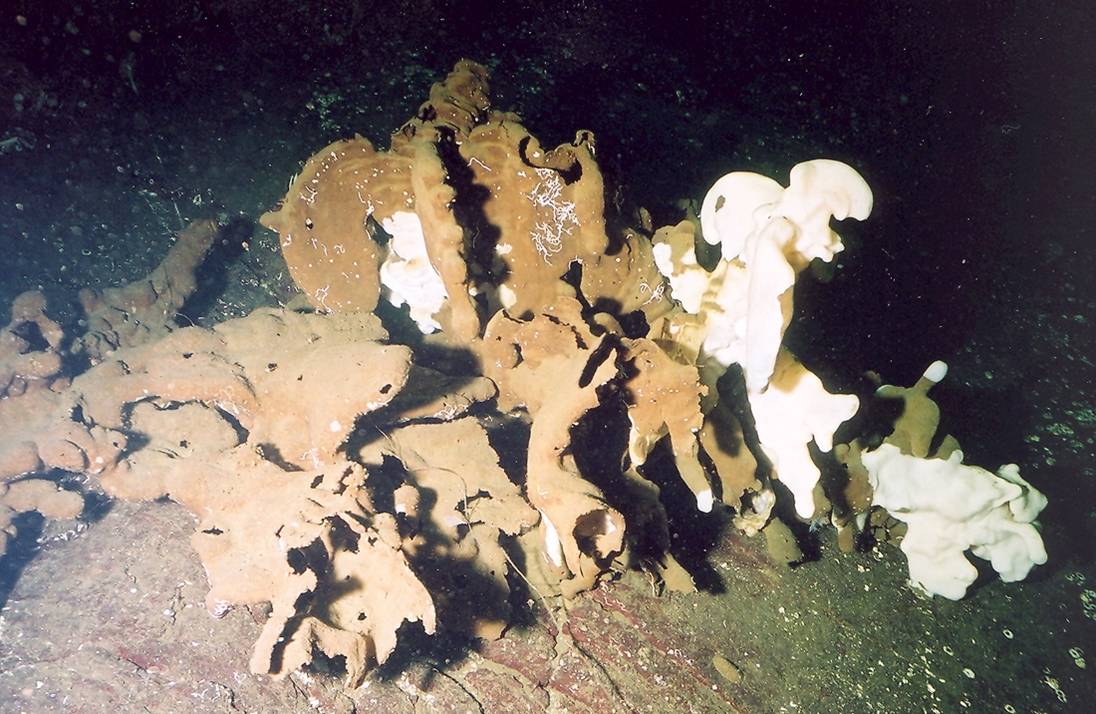Protecting Sponge Gardens
The main skeleton of Cloud Sponges is formed of fused strands of glass. For this reason they are
extremely fragile and are at risk of being shattered from human activities such as fishing and diving. There are a
number of ways in which the human impacts on these Sponge Gardens can be greatly reduced.
Are You A Prawn Fisher? In Saanich Inlet sponges occur only shallower than 230 ft. Here prawn fishers can avoid damaging sponges by keeping their traps below 250 ft. as long as the water has oxygen. However, in other inlets sponges may be destroyed at depths down to 400 feet. On an Easter weekend, biologists mapped the locations of 64 prawn traps (red dots) in the recreational fishery in Saanich Inlet, B.C.. Commercial fishermen can each deploy 150 to 300 traps at a time.
Are you a Crab Fisher? Please keep traps shallower than 100 ft. and on soft bottoms.
Are You A Line Fisher? Please lift up cannonballs and lines to shallower than 100 ft. when near known sponge gardens such as in Saanich Inlet.
Are you a scuba diver? Practice outside the sponge beds, avoid flailing kicks, adjust your buoyancy to stay off bottom and photograph but don’t touch.
This sponge was torn in two by a cannonball or a prawn trap. It subsequently died and became covered with silt. It is likely the plumbing of the pumping system had become too disrupted. Most sponges breakdown when they die, however, the mainframe skeleton of a Cloud Sponge remains intact for at least decades.
Examples of common things that cause damage to glass sponge gardens: fishing cannonball, prawn trap, scuba diver.
Commercial Fishing
Bottom trawling is an indiscriminate method of fishing that damages and destroys structurally complex habitats. Bottom trawls are a type of mobile fishing gear consisting of very large nets that are dragged on the seafloor to catch ground fish and other species. The attachment of large, heavy roller and rockhopper gear to bottom trawl nets, in combination with more powerful fishing boats and other technical innovations are far more damaging that what was used before the 1980's.
Sediment
Not all impacts are physical. Suspended sediment in the water like smog in air can affect organisms in a variety of ways.
The map shows sedimentation rates in blue, in grams per square meter per year in Saanich Inlet (after Drinnen 1995). Note that rates increase toward the mouth of the Saanich Inlet. This is opposite to the condition in most fjords. (e.g., Farrow et al 1983). The distribution of the Cloud Sponge is shown in red. It does not occur where sedimentation rates exceed roughly 1000 grams per square meter per year
High suspended sediment may be produced naturally by glaciers.
High suspended sediment may also be the result of stirring up the bottom by log dumps removal of cover by clear cutting exposure of soil by development or loosening soil such as by agriculture.
Pisces Exploration
Back in 1982 divers in the PISCES submersible saw sponge skeletons some 30 meters (100 ft) below any living sponges. This means that some time in the past the oxygenated water extended 30 meters deeper into the basin. A likely explanation is that there was less pollution by nutrients from, for example, farming, clear cutting, landscaping, sewage, and maybe global warming. It we could date the sponges; we might be able to identify events which caused lowered oxygen. These dead sponges might also tell us that low or no oxygen water may extend into shallower water in the future.
Each year the oxygen in the basin of Saanich Inlet gets used up. The walls of the inlet here are barren
At Christmas Pt., in Saanich Inlet only 8% of the sponges had dead bases while at Senanus Reef in Saanich Inlet 80% of the sponges had dead bases
The rate of sedimentation is twice as high at Senanus Reef compared to Christmas Pt.
While amount of sedimentation or associated high suspended particulates may be correlated with % of dead bases, we cannot exclude some other factor(s).
How glass sponges respond to artificial addition of sediment is discussed under “keeping clean” in the Natural History Section.
DFO ANNOUNCEMENT REGARDING SPONGE REEF CONSERVATION
Fisheries and Oceans Canada has implemented fishing closures to protect nine glass sponge reefs in the Strait of Georgia and Howe Sound. Commercial and recreational bottom-contact fishing is prohibited within 150 metres of all nine glass sponge reefs. FN0415
Effective June 12, 2015 all commercial and recreational bottom contact fishing activities for prawn, shrimp, crab and groundfish (including halibut) were prohibited within the areas listed below in order to protect the Strait of Georgia and Howe Sound Glass Sponge Reefs. These closures will be in effect until further notice.
On April 1, 2016 these closures also went into effect for all First Nation Food, Social and Ceremonial (FSC) fisheries that participate in bottom contact fishing activities for prawn, shrimp, crab and groundfish.
British Columbia’s ancient glass sponge reefs are a globally unique ecosystem that provides important habitat for many marine animals including spot prawns, rockfish, herring, halibut, and sharks.
The protection of coral and sponge reefs is a key component to a number of international commitments made by Canada through the United Nations Convention on Biological Diversity and the United Nations Food and Agriculture Organization (FAO) Code of Conduct for Responsible Fisheries.











